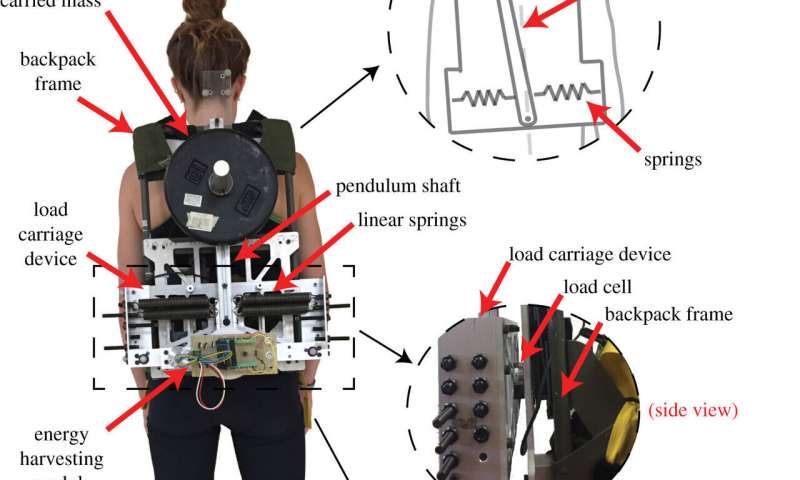July 10, 2019 weblog
A backpack that generates electricity using side-to-side movement from walking

A pair of researchers with the Mechanical and Materials Engineering and Ingenuity Labs at Queen's University has designed a backpack that harnesses the energy from the side-to-side movement of a person walking. In their paper published in Royal Society Open Science, Jean-Paul Martin and Qingguo Li describe their design and the ways they believe it could be used.
Biomechanical energy harvesters are devices that are attached to or carried by humans and generate electricity by harvesting energy from movements. Some examples include devices that are attached to shoes or even a shirt. Such devices have thus far not been able to produce enough electricity to be useful, however. In this new effort, the researchers sought to create a harvester that can produce enough electricity to power a small device. The result of their efforts is a backpack that captures energy from a body swaying from side to side, which is what happens when a person is walking.
The device consists of a weight attached to the top part of a pendulum, which swings back and forth as a person is walking—the weight gives it more momentum. The bottom end of the pendulum runs into springs on either side of the device, which are connected to the energy harvesting module. The device is encased in a frame that can be placed inside a backpack. The researchers built differently sized devices to allow for generating varying amounts of electricity. Generating more electricity required adding more weight to the top of the pendulum. They report that when the device was outfitted with a 20-pound weight, it was able to generate enough electricity to power an emergency beacon or a GPS handset. They note that the weight of the device and backpack add another 11 pounds. Adding 35 more pounds of weight allowed the device to generate enough electricity to power a smartphone.
The researchers suggest their device could be used by people who work or live in remote areas, such as scientists or explorers. The advantage of their design, they claim, is that the user does not have to engage in any other activity to generate electricity, such as cranking a handle. The note also that they plan to continue working on the design with the goal of reducing weight without loss of power generation.
More information: Jean-Paul Martin et al. Generating electricity while walking with a medial–lateral oscillating load carriage device, Royal Society Open Science (2019). DOI: 10.1098/rsos.182021
© 2019 Science X Network
















